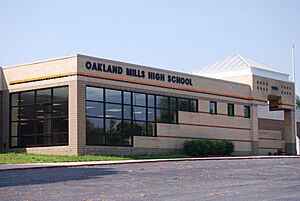Oakland Mills, Columbia, Maryland facts for kids
Quick facts for kids
Oakland Mills
|
|
|---|---|
|
Village
|
|
| Country | United States |
| State | Maryland |
| City | Columbia |
| Established | 1968 |
| Named for | Oakland Mill |
Oakland Mills is one of the 10 villages in Columbia, Maryland, United States. It is located just east of the main Town Center. It sits across U.S. Route 29.
The village of Oakland Mills includes three main neighborhoods: Steven's Forest, Talbott Springs, and Thunder Hill.
Contents
History of Oakland Mills
The name Oakland Mills comes from an old mill and postal station in the area. These were part of a large 2,300-acre estate. This estate included a big farm called Oakland Manor. An old grist mill from 1796 was near a road built in 1810. This road is now U.S. Route 29.
The Oakland Mills Blacksmith House and Shop was built around 1820. Other shops like a sawmill and a country store were built nearby before 1824. The Oakland Mills postal station opened in 1821. It closed in 1909. The name was used again in 1974 by the Rouse Company. This company developed the land for the new village.
In 1969, the Rouse Company began building the modern village of Oakland Mills. The village officially opened on November 11, 1969, with its new village center. Different builders created homes in the Stevens Forest neighborhood. These homes had various styles, including modern and traditional designs. In 1971, some new homes under construction were damaged by fire. This led residents to start community watch groups.
In 1987, the state of Maryland and Howard County approved widening a road. This affected some historic buildings at the original Oakland Mills site. In 2011, the Blacksmith House was added to the National Register of Historic Places. This means it is recognized as an important historical site.
The Footbridge Over Route 29
A concrete footbridge was built in 1982. It connected Oakland Mills to the nearby Columbia Town Center. In 2010, a plan for downtown Columbia was approved. This plan required the developer to pay for a new footbridge. This was a condition for building more in Columbia.
In 2010, The Rouse Company studied the bridge. They said it didn't help much with transportation. However, in 2012, the county decided to use $600,000 of its own money for a new bridge. In 2013, Howard County spent $100,000 on another study. In 2018, the bridge was updated. It now has a new spiraling design, better lighting, and improved safety features.
Neighborhood Names
The neighborhoods in Oakland Mills have interesting names. These names often come from old land grants or famous authors.
Steven's Forest Neighborhood
Steven's Forest is named after a large land area. This land was first given to Charles Stevens in 1709. Later, in 1787, a general named Charles Sterrett Ridgely combined several land areas. These included "Stevens Forest" to create a 1,696-acre property. This property was part of the Oakland Manor estate.
The streets in Steven's Forest are named after the works of famous writers. These include John Dos Passos, F. Scott Fitzgerald, and Ernest Hemingway.
Talbott Springs Neighborhood
Talbott Springs gets its name from an old land grant called Talbott's Resolution Manor. This land was first given to John and Elizabeth Talbot in 1714.
Street names in Talbott Springs come from the works of poets. These include Carl Sandburg and Ralph Waldo Emerson.
Thunder Hill Neighborhood
Thunder Hill is named after a farm owned by Oliver Goldsmith. He sold his property to the Rouse Company. The street names in Thunder Hill are from the works of artist Andrew Wyeth. One street, "Coonhunt Court," caused some discussion. Efforts to change its name began in 1969.
Community Services
The Oakland Mills Village Center has an LA Mart grocery store. It also has other smaller shops, including a Dunkin'. "The Meeting House" is located at the village center. It is a place for different faiths to gather.
The community center is in a building called The Other Barn. This building was originally a barn built in 1947 for cattle. In 1969, the Rouse Company changed it into a community center. It also had a teen center called the Orange Propeller.
Each neighborhood in Oakland Mills has its own outdoor swimming pool. The Columbia Ice Rink and the Youth and Teen Center are also part of the Oakland Mills Village Center. The Columbia Association manages these facilities.
Village Leadership
The Oakland Mills Community Association is like the homeowner's association for the village. It also serves as the village's board of directors. Members of the village board are elected every year. They serve for one-year terms. The board can have up to seven members. It includes the Oakland Mills representative to the Columbia Council. A Village Manager helps run the community association every day.
Current village board members include:
- Jonathan Edelson – Chairperson
- William McCormack, Jr. – Vice Chairperson
- Jerome Rollerson – acting Architecture Chairperson
- Rebecca Bryant
- Warren Wortman
- Virginia Thomas – Columbia Council Representative
Education in Oakland Mills
Oakland Mills High School is located in the village. Students from Oakland Mills and nearby areas attend this school.
There are three elementary schools in the village:
- Stevens Forest Elementary School
- Thunder Hill Elementary School
- Talbott Springs Elementary School
There is also one middle school:
- Oakland Mills Middle School
Both Stevens Forest Elementary School and Talbott Springs Elementary School have been recognized as National PTA Schools of Excellence. This means they are great places for students and families.



